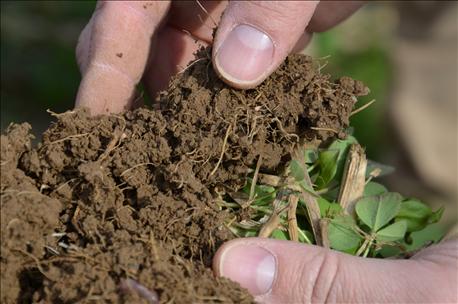
Is soil loss ever tolerable? Ever wonder why fence rows are always higher than the cropped field? Where did all the soil in the field beside the fence rows go? Did you donate it to your neighbor, or did it wash away downstream?
These are questions posed by the Indiana Conservation Partners, responsible for spawning the new column Salute Soil Health, which appears in Indiana Prairie Farmer magazine. Natural Resources Conservation Service staff, including Shannon Zezula, state resource conservationist, assemble helpful tips and information related to soil conservation and building soil health for each issue of the magazine.

WHAT SOIL HEALTH CAN DO: Cover crops not only protect the soil from erosion, but also tend to rebuild soil health.
For years soil conservationists have talked about "tolerable limits" for soil loss. The first statewide Indiana soil conservation program backed by state dollars, not federal dollars, was T by 2000, created in the mid-1980s. The goal was to reduce erosion on all lands to the T, or tolerable, level by the year 2000. Many soils were eroding well above the T level. While some still are, soil erosion has been greatly reduced on hundreds of thousands of acres since then. T by 2000 became Clean Water Indiana as the decade of the 2000s approached.
Tolerable soil loss for many soils is 4 tons per acre per year, NRCS specialists say. What "tolerable limit" really means, assuming soil erosion will never be reduced to zero, is the amount that soil conservationists say you can live with and still keep soils productive.
However, over 40 years, 4 tons of soil lost per acre per year is 160 tons of soil from one acre. That is 16 dump truck loads, each carrying 10 tons of soil. That’s why some are now asking if any soil loss is really tolerable, Zezula says.
Instead, they suggest starting a soil health system that includes no-till and cover crops. Implementing these practices will greatly reduce soil loss and take “tolerable” out of the equation. This would significantly reduce the soil you would lose over two generations, specialists say.
Famers using no-till and cover crops to improve soil health and reduce erosion may be redefining what it means to do a good job of protecting the soil. Dropping soil loss to T, once thought a big accomplishment, may not be good enough. It’s a start, but those making soil health work for them are showing that it's possible to go well beyond reducing soil erosion to the tolerable limit. It’s even possible to begin building back soil organic matter.
Someday, "tolerable limit" may be a term of the past. "Soil health" is the term of today, and of the future.
About the Author(s)
You May Also Like




